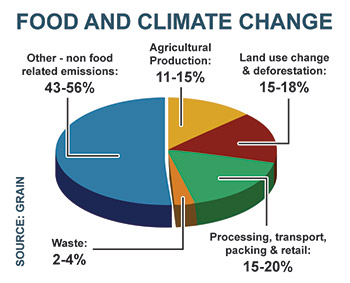Record-breaking heat waves, long-term drought, “100-year floods” in consecutive years, and increasingly extreme superstorms are becoming the new normal. The planet is now facing an unprecedented era of accelerating and intensifying global climate change, with negative impacts already being widely felt. While global climate change will impact nearly everyone and everything, the greatest impact is already being felt by farmers and anyone who eats food.
When we think of climate change and global warming, visions of coal-fired power plants and solar panels come to mind. Policy discussions and personal action usually revolve around hybrid cars, energy-efficient homes and debates about the latest technological solutions. However, the global agriculture system is at the heart of both the problem and the solution.
Industrial agriculture is a key driver in the generation of greenhouse gases (GHGs). Synthetic fertilizers, pesticides, heavy machinery, monocultures, land change, deforestation, refrigeration, waste and transportation are all part of a food system that generates significant emissions and contributes greatly to global climate change. Industrial agricultural practices, from Concentrated Animal Feeding Operations (CAFOs) to synthetic fertilizer-intensive corn and soy monocultures, genetically modified to tolerate huge amounts of herbicide, not only contribute considerable amounts of GHGs, but also underpin an inequitable and unhealthy global food system. Modern conventional agriculture is a fossil fuel-based, energy-intensive industry that is aligned with biotech, trade and energy interests, versus farmer and consumers priorities.
Farms and farmers are in the crosshairs of climate change. Though farmers have seen negative impacts related to climate change for decades, these impacts have been exacerbated in recent years. Even relatively small temperature increases are having significant impacts on farming, including accelerated desertification and salinization of arable land, increased presence of pests, crop losses due to high temperatures and flooding, and, paradoxically, increased clean water scarcity.

